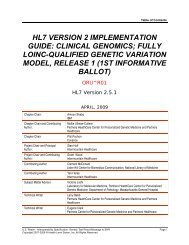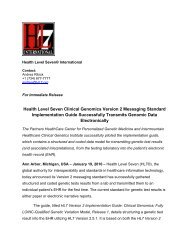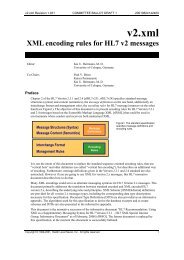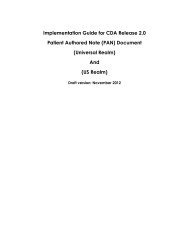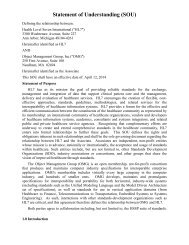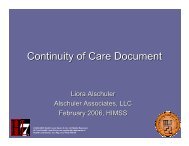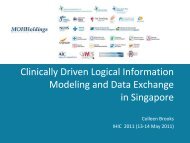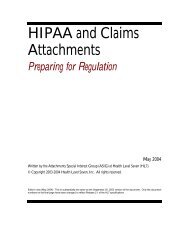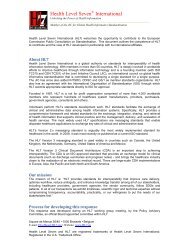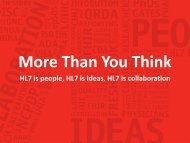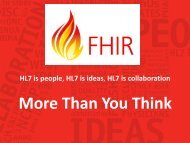HL7 CDA R2 AIS Implementation Guide
HL7 CDA R2 AIS Implementation Guide
HL7 CDA R2 AIS Implementation Guide
You also want an ePaper? Increase the reach of your titles
YUMPU automatically turns print PDFs into web optimized ePapers that Google loves.
<strong>HL7</strong> Additional Information Specification <strong>Implementation</strong> <strong>Guide</strong><strong>CDA</strong><strong>R2</strong><strong>AIS</strong>0000R0303.3 General Compliance StatementsThe following compliance statements apply to all <strong>CDA</strong> documents proffered as attachments.[Make the following head-3 and ensure style agreement with all other compliance statements]1) <strong>CDA</strong> Compliant. The document shall be compliant with Health Level Seven (<strong>HL7</strong>)Clinical Document Architecture, Release 2.0, April 2005 (ANSI/<strong>HL7</strong> <strong>CDA</strong> <strong>R2</strong>-2005).2) <strong>CDA</strong> Namespace. The document shall use a namespace with the Uniform ResourceIdentifier (URI) "urn:hl7-org:v3" for elements in the <strong>CDA</strong> schema.3) Self-Contained Package. Unless a specific Additional Information Specificationspecifically overrides this provision, the interpretation of the attachment shall not dependon any information that is not included in the attachment package.This statement means that a compliant health plan need not perform documentmanagement with respect to revisions of the submitted document. Decisions will be madeon the basis of the transmitted document without regard to whether it is an updated oramended version of a prior document. This does not preclude a payer from requestinganother attachment once an attachment has already been requested and received. TheHIPAA federal regulations (i.e., the "final rule") for claims attachments will define therules regarding when it is appropriate to request more supporting documentation.It also means that if a submitted document contains a URL that references informationotherwise not included in the attachment package (e.g., available only through theinternet), a compliant health plan does not need to retrieve and render the referencedinformation in order to make a decision based on the document. This is consistent withthe <strong>CDA</strong> rule that the information referred to by such URLs are not part of the attestablecontent of the <strong>CDA</strong> document.At publication date no Additional Information Specifications will override thiscompliance statement. We are holding out the option that the use case of a specificAdditional Information Specification in the future might justify something like Internetaccess to related data.4) Deprecate and Limit Recipient Obligations for Confidentiality Elements. Providersshould not include any of the following elements anywhere in a compliant <strong>CDA</strong>attachment document:section/confidentialityCode,structuredBody/confidentialityCode, andnonXMLBody/confidentialityCode.If, however, a provider transmits an attachment document that includes these elements,the health plan is not obligated to give the document any special handling beyond itsnormal policies for dealing with personally identifiable health information.Page 40March 2007Copyright © 1998-2007Health Level Seven, Inc. All rights reserved.Release 3.0 Draft Standard




